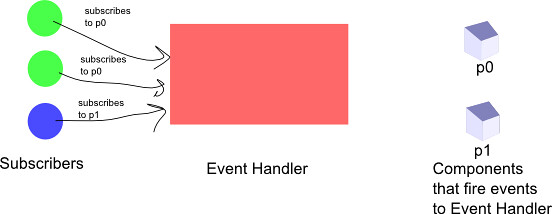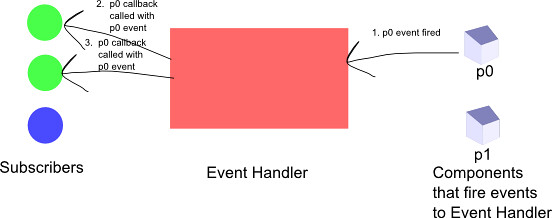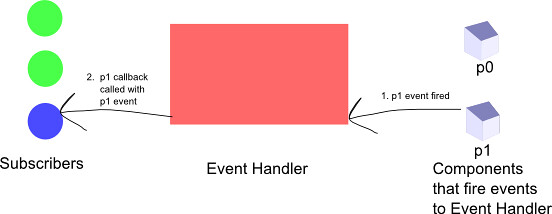jQuery plugin for Event Driven Architecture?
سؤال
Are there any Event Driven Architecture jQuery plugins?
Step 1: Subscribing

The subscribers subscribe to the event handler in the middle, and pass in a callback method, as well as the name of the event they are listening for...
i.e. The two green subscribers will be listening for p0 events. And the blue subscriber will be listening for p1 events.
Step 2: The p0 event is fired by another component to the Event Handler

- A p0 event is fired to the Event Handler
- The event handler notifies it's subscribers of the event, calling the callback methods they specified when they subscribed in Step 1: Subscribing.
Note that the blue subscriber is not notified because it was not listening for p0 events.
Step 3: The p1 event is fired a component to the Event Handler

The p1 event is fired by another component
Just as before except that now the blue subscriber receives the event through its callback and the other two green subscribers do not receive the event.
I can't seem to find one, but my guess is that they just call it something else in Javascript/jquery
Also is there a name for this pattern? Because it isn't just a basic publisher/subscriber, it has to be called something else I would think.
المحلول
You probably don't need a plugin to do this. First of all, the DOM itself is entirely event driven. You can use event delegation to listen to all events on the root node (a technique that jQuery live uses). To handle custom events as well that may not be DOM related, you can use a plain old JavaScript object to do the job. I wrote a blog post about creating a central event dispatcher in MooTools with just one line of code.
var EventBus = new Class({Implements: Events});
It's just as easy to do in jQuery too. Use a regular JavaScript object that acts as a central broker for all events. Any client object can publish and subscribe to events on this object. See this related question.
var EventManager = {
subscribe: function(event, fn) {
$(this).bind(event, fn);
},
unsubscribe: function(event, fn) {
$(this).unbind(event, fn);
},
publish: function(event) {
$(this).trigger(event);
}
};
// Your code can publish and subscribe to events as:
EventManager.subscribe("tabClicked", function() {
// do something
});
EventManager.publish("tabClicked");
EventManager.unsubscribe("tabClicked");
Or if you don't care about exposing jQuery, then simply use an empty object and call bind and trigger directly on the jQuery wrapped object.
var EventManager = {};
$(EventManager).bind("tabClicked", function() {
// do something
});
$(EventManager).trigger("tabClicked");
$(EventManager).unbind("tabClicked");
The wrappers are simply there to hide the underlying jQuery library so you can replace the implementation later on, if need be.
This is basically the Publish/Subscribe or the Observer pattern, and some good examples would be Cocoa's NSNotificationCenter class, EventBus pattern popularized by Ray Ryan in the GWT community, and several others.
نصائح أخرى
Though not a jQuery plugin, Twitter released a JavaScript framework called Flight which allows you to create component-based architectures, which communicate via events.
Flight is a lightweight, component-based JavaScript framework from Twitter. Unlike other JavaScript frameworks which are based around the MVC pattern, Flight maps behavior directly to DOM nodes.
Flight is agnostic to how requests are routed or which templating library you decide to use. Flight enforces strict separation of concerns. Components in Flight do not engage each other directly.
They broadcast their actions as events and those components subscribed to those events can take actions based on them. To make use of Flight, you will need the ES5-shim and jQuery along with an AMD loader.
Flight - A Lightweight, Component-Based JavaScript Framework From Twitter
There are actually two of them:
- Listen (faster): http://plugins.jquery.com/project/Listen
- Intercept (more advanced): http://plugins.jquery.com/project/Intercept
Could this serve as a ligthweight message passing framework?
function MyConstructor() {
this.MessageQueues = {};
this.PostMessage = function (Subject) {
var Queue = this.MessageQueues[Subject];
if (Queue) return function() {
var i = Queue.length - 1;
do Queue[i]();
while (i--);
}
}
this.Listen = function (Subject, Listener) {
var Queue = this.MessageQueues[Subject] || [];
(this.MessageQueues[Subject] = Queue).push(Listener);
}
}
then you could do:
var myInstance = new MyConstructor();
myInstance.Listen("some message", callback());
myInstance.Listen("some other message", anotherCallback());
myInstance.Listen("some message", yesAnotherCallback());
and later:
myInstance.PostMessage("some message");
would dispatch the queues
This can easily be accomplished using a dummy jQuery node as a dispatcher:
var someModule = (function ($) {
var dispatcher = $("<div>");
function init () {
_doSomething();
}
/**
@private
*/
function _doSomething () {
dispatcher.triggerHandler("SOME_CUSTOM_EVENT", [{someEventProperty: 1337}]);
}
return {
dispatcher: dispatcher,
init: init
}
}(jQuery));
var someOtherModule = (function ($) {
function init () {
someModule.dispatcher.bind("SOME_CUSTOM_EVENT", _handleSomeEvent)
}
/**
@private
*/
function _handleSomeEvent (e, extra) {
console.log(extra.someEventProperty) //1337
}
return {
init: init
}
}(jQuery));
$(function () {
someOtherModule.init();
someModule.init();
})
A recent development is msgs.js "Message oriented programming for JavaScript. Inspired by Spring Integration". It also supports communication via WebSockets.
msgs.js applies the vocabulary and patterns defined in the 'Enterprise Integration Patterns' book to JavaScript extending messaging oriented programming into the browser and/or server side JavaScript. Messaging patterns originally developed to integrate loosely coupled disparate systems, apply just as well to loosely coupled modules within a single application process.
[...]
Tested environments:
- Node.js (0.6, 0.8)
- Chrome (stable)
- Firefox (stable, ESR, should work in earlier versions)
- IE (6-10)
- Safari (5, 6, iOS 4-6, should work in earlier versions)
- Opera (11, 12, should work in earlier versions)
I have used the OpenAjax Hub for its publish/subscribe services. It's not a jQuery plugin, but a standalone JavaScript module. You can download and use the reference implementation from SourceForge. I like the hierarchical topic naming and the support for subscribing to multiple topics using wildcard notation.